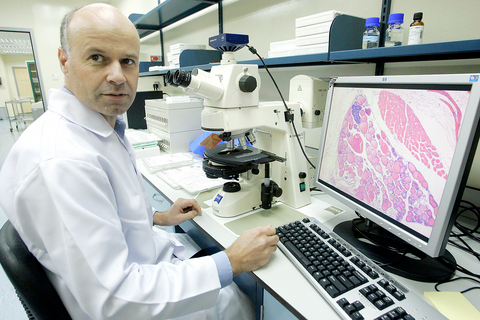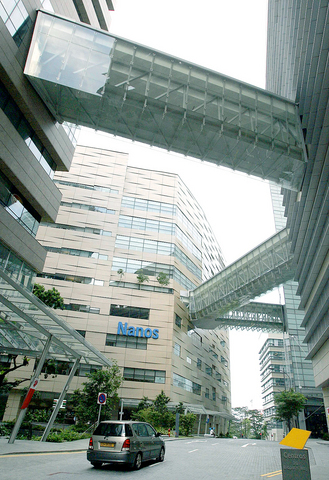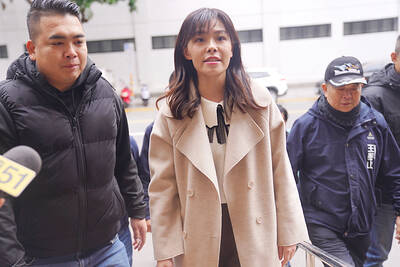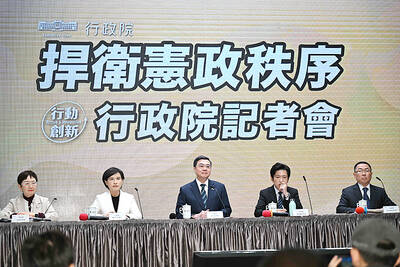Singapore believes it has seen the future, and its name is the Biopolis.
The sparkling new US$300 million suburban complex of angular buildings, erected on hilly ground next to the Ministry of Education, is the nerve center of the city-state's campaign to become a global science hub.
Scientists from Europe, North America and Asia are now relocating to the Biopolis, thanks to attractive salaries, an expatriate-friendly environment and relatively liberal rules on cutting-edge fields like stem cell research.

PHOTO: AFP
At the same time, more than 500 of Singapore's brightest students are now being sent to top foreign universities to earn doctorates and lead Singapore's charge into the brave new world of biomedical industries in the 21st century.
With assembly-line manufacturing under long-term threat from lower-cost countries, Singapore is banking on science as a new economic growth engine.
It hopes a thriving research sector will produce a long-term windfall from patented discoveries and steadily reduce Singapore's heavy dependence on the cyclical and increasingly crowded electronics sector.

PHOTO: AFP
"Never fall in love with an industry," said Philip Yeo, the co-chairman of the Economic Development Board (EDB), the investment promotion agency that was instrumental in Singapore's rise as a top electronics production center.
Now, as concurrent head of the Agency for Science, Technology and Research, Yeo is nudging Singapore toward "knowledge economy" industries centered at the Biopolis, where brains, investment and public funding are all in one place.
"The day we relax, we're a goner," Yeo said.
The academics are literally being turned into poster boys and girls of the agency to convince students to take up science as a profession.
"In Singapore we don't glorify footballers," Yeo said.
It will cost up to US$600,000 to finance the education of each student from a basic university degree to a full-blown doctorate, eight years of study which the student must repay with six years of service to the government.
About 15 percent of the academics are naturalized citizens.
One of them is Chinese-born Liang Jing, 24, who is pursuing a degree in biomedical engineering at the University of Michigan. He is the only child of an engineer and his wife who migrated to Singapore when he was 11.
"I do not come from a wealthy family. Without this scholarship, I would probably do a local engineering degree instead," he said by e-mail.
Liang said he wants to someday head "a self-sustaining research institute in Singapore that does not depend on government funding once established."
Yeo says the country wants "hungry kids from the region" to help power its scientific ambitions.
"Intelligence is not enough. You need hunger," he said.
Science academics are in Yeo's words "more expensive than an infantry battalion" but Singapore can well afford it -- it has close to US$120 billion in foreign reserves.
The first of the newly-minted doctors will return in 2008 and 2009 to jobs with starting salaries of more than US$40,000 a year, and stand to earn much more in the private sector after they complete their government study bonds.
It's already well-known in the scientific world that Singapore is out to lure some of the best names in basic research.
One of those who have moved here is Alan Coleman, the British scientist who in 1996 delivered Dolly the sheep, the world's first cloned mammal.
When the Biopolis is fully occupied, it can host about 2,000 scientists engaged in stem cell, cancer and other forms of fundamental research aimed at finding cures for some of the oldest and most debilitating diseases.
In buildings named Matrix, Centros, Nanos, Genome, Helios, Chromos and Proteos interlinked by pedestrian skyways, scientists in laboratory coats and jeans work in meticulously planned surroundings at the Biopolis.
The buildings are clustered around a courtyard with restaurants, a wine bar, a convenience store and a hair salon.
There's a laundry that also sells laboratory coats.
Old trees have been planted in the middle of the courtyard, with artificial waterfalls and a carp pond giving the Biopolis a park-like atmosphere.
A prison next door where some shirtless inmates can still be seen from the laboratories will give way to the further expansion of the Biopolis, which will also have its own business hotel, condominium and gourmet restaurants.
"The key is to bring in critical mass, co-locate," Yeo said.
The Singapore government itself has an investment arm, BioOne Capital Pte Ltd, which manages more than US$700 million in funds invested in biomedical business ventures worldwide including some in Biopolis itself.
One of the foreign companies now operating there is British firm Paradigm Therapeutics, which specializes in early-stage drug discovery particularly for the central nervous system, metabolic diseases and pain. It now employs nine scientists at Biopolis and plans to double its staff over the next year.
Ian Gray, its director of research, said Singapore's stable infrastructure, English-speaking environment and strong skills base in molecular biology and cell culture were strong attractions for his firm.
"We have samples that are stored at minus 80 degrees. We can't afford for the power to go down for any length of time," he said.
A high-level panel has recommended the doubling of Singapore's research and development spending to more than US$7 billion over the next five years, which means more scholarships for Singaporeans, native or naturalized.
Prime Minister Lee Hsien Loong, a British-educated mathematician, announced over the weekend that he will chair a new Research, Innovation and Enterprise Council that will oversee the ambitious drive to make money out of science.
"There are risks in this approach, but we have to do this," Lee said. "If we succeed, we will gain competitive advantage that puts us ahead for 15 to 20 years."

The US government has signed defense cooperation agreements with Japan and the Philippines to boost the deterrence capabilities of countries in the first island chain, a report by the National Security Bureau (NSB) showed. The main countries on the first island chain include the two nations and Taiwan. The bureau is to present the report at a meeting of the legislature’s Foreign Affairs and National Defense Committee tomorrow. The US military has deployed Typhon missile systems to Japan’s Yamaguchi Prefecture and Zambales province in the Philippines during their joint military exercises. It has also installed NMESIS anti-ship systems in Japan’s Okinawa

‘WIN-WIN’: The Philippines, and central and eastern European countries are important potential drone cooperation partners, Minister of Foreign Affairs Lin Chia-lung said Minister of Foreign Affairs Lin Chia-lung (林佳龍) in an interview published yesterday confirmed that there are joint ventures between Taiwan and Poland in the drone industry. Lin made the remark in an exclusive interview with the Chinese-language Liberty Times (the Taipei Times’ sister paper). The government-backed Taiwan Excellence Drone International Business Opportunities Alliance and the Polish Chamber of Unmanned Systems on Wednesday last week signed a memorandum of understanding in Poland to develop a “non-China” supply chain for drones and work together on key technologies. Asked if Taiwan prioritized Poland among central and eastern European countries in drone collaboration, Lin

BACK TO WORK? Prosecutors said they are considering filing an appeal, while the Hsinchu City Government said it has applied for Ann Kao’s reinstatement as mayor The High Court yesterday found suspended Hsinchu mayor Ann Kao (高虹安) not guilty of embezzling assistant fees, reducing her sentence to six months in prison commutable to a fine from seven years and four months. The verdict acquitted Kao of the corruption charge, but found her guilty of causing a public official to commit document forgery. The High Prosecutors’ Office said it is reviewing the ruling and considering whether to file an appeal. The Taipei District Court in July last year sentenced Kao to seven years and four months in prison, along with a four-year deprivation of civil rights, for contravening the Anti-Corruption

NO CONFIDENCE MOTION? The premier said that being toppled by the legislature for defending the Constitution would be a democratic badge of honor for him Premier Cho Jung-tai (卓榮泰) yesterday announced that the Cabinet would not countersign the amendments to the local revenue-sharing law passed by the Legislative Yuan last month. Cho said the decision not to countersign the amendments to the Act Governing the Allocation of Government Revenues and Expenditures (財政收支劃分法) was made in accordance with the Constitution. “The decision aims to safeguard our Constitution,” he said. The Constitution stipulates the president shall, in accordance with law, promulgate laws and issue mandates with the countersignature of the head of the Executive Yuan, or with the countersignatures of both the head of the Executive Yuan and ministers or